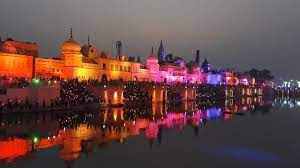The term Ayodhya has the literal meaning of “unassailable” in the Sanskrit language.
Ayodhya is a historic and Sacred city (tirtha) on the Sarayu River in Uttar Pradesh's Faizabad district, and one of India's seven sacred towns.
- Ayodhya is renowned for being the location for most of the Ramayana, the second of two major Hindu epics in which the deity Rama is the central figure.
- Ayodhya is the capital city of Rama's father, King Dasharatha, as well as the birthplace and boyhood home of Rama and his siblings, as well as the city to which Rama returns triumphantly after his exile.
- Although scholars have questioned the historical accuracy of the Ramayana and the authenticity of the events depicted in it, Rama's followers (bhakta) have no such reservations.
The worship of Rama is firmly rooted in Ayodhya, and numerous locations around the city are connected with events from the epic that are believed to have happened.
- With the exception of the Ram Janam Bhumi, the location regarded as Rama's birthplace, this has had no negative consequences.
- The Babri Masjid, a Muslim mosque allegedly constructed after the previous temple was destroyed, occupied this location until 1992.
- The mosque was demolished by organized teams of Hindu activists from the Vishva Hindu Parishad on December 6, that year, in little over six hours.
Thousands of people were murdered in Hindu-Muslim communal riots throughout India as a result of the damage.
- These actions have now culminated in the reconstruction of a Lord Ram temple.
- Hindus will once again resume the commemoration and worship of Lord Ram at Ayodhya.
See Hans Bakker's Ayodhya (1986); Peter van der Veer's Gods on Earth (1988); Sarvepalli Gopal's Anatomy of a Confrontation (1991); and Christophe Jaffrelot's The Hindu Nationalist Movement in India (1996) for more information on Ayodhya.
You may also want to read more about Hinduism here.
Be sure to check out my writings on religion here.







